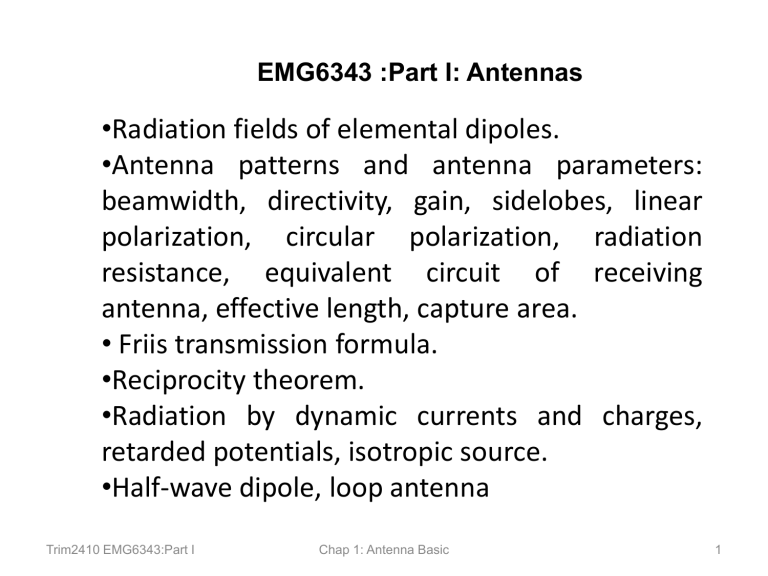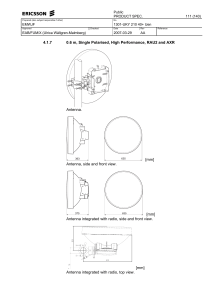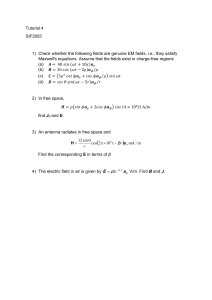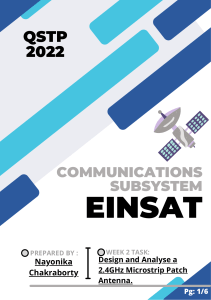
EMG6343 :Part I: Antennas •Radiation fields of elemental dipoles. •Antenna patterns and antenna parameters: beamwidth, directivity, gain, sidelobes, linear polarization, circular polarization, radiation resistance, equivalent circuit of receiving antenna, effective length, capture area. • Friis transmission formula. •Reciprocity theorem. •Radiation by dynamic currents and charges, retarded potentials, isotropic source. •Half-wave dipole, loop antenna Trim2410 EMG6343:Part I Chap 1: Antenna Basic 1 Text and Reference • D.K. Cheng, “Field and waves electromagnetic”, 2nd Ed, 1989, Addison-Wesley. • Matthew N. O. Sadiku, “Elements of Electromagnetics”, Saunders College Publishing. • Kraus & Fleisch, “Electromagnetics – with applications”, McGraw Hill • Kraus & Marhefka, “Antennas – for all applications”, McGraw Hill • C. A. Balanis, “Antenna theory – analysis and design”, Wiley. Trim2410 EMG6343:Part I Chap 1: Antenna Basic 2 Definition of Antenna • That part of a transmitting or receiving system that is designed to radiate or to receive electromagnetic waves. • A transducer between a guided wave propagating in a transmission line and an electromagnetic wave propagating in an unbounded medium (usually free space), or vice versa. Trim2410 EMG6343:Part I Chap 1: Antenna Basic 3 Types of radiating structures Trim2410 EMG6343:Part I Chap 1: Antenna Basic 4 Wire antenna (half wave dipole) The most basic form of antenna, and most popular Transmission line /2 Radiation pattern of a 2 thin wire dipole – omnidirectional Trim2410 EMG6343:Part I E-plane Chap 1: Antenna Basic Total length of the radiating element is halfwavelength H-plane 5 Input impedance of a half-wave dipole is complex with; Real part having a radiation resistance of & ~73 + the ohmic loss of the wire Imaginary part is ~42, but decreases to 0 if length of dipole is reduced by 4%. Thus, by trimming the dipole by 4%, the input impedance is purely real, and ~73, making it possible to match to a 75 transmission line. Trim2410 EMG6343:Part I Chap 1: Antenna Basic 6 Quarter wave monopole • A quarter-wave monopole antenna excited by a source at its base exhibits the same radiation pattern in the region above the ground plane as a half-wave dipole in free space • Use image theory for analysis Trim2410 EMG6343:Part I Chap 1: Antenna Basic 7 Dipole of other lengths Trim2410 EMG6343:Part I Chap 1: Antenna Basic 8 Short Electric Dipole What is a “short” dipole? L An infinitesimal linear wire positioned symmetrically at the origin of the coordinate system and oriented along the z-axis. Why do we need to study short dipole? Any linear antenna may be considered as consisting of a large number of very short conductors connected in series. It is the oldest, simplest, cheapest and in many cases, the most versatile. Trim2410 EMG6343:Part I Chap 1: Antenna Basic 9 What makes a short dipole? Length L is very short compared to wavelength (L<<). Carries uniform current I along the entire length L. To allow such uniform current, we attach plates at the ends of the dipole as capacitive load. However, we assume the plates are small that their radiation is negligible. The dipole may be energized by balanced transmission line. However, it is assumed that the transmission line does not radiate. +q L I The diameter d of the dipole is small compared to its length (d<<L). Thus a short dipole consist simple of a thin conductor of length L with a uniform current I and point charges q at the ends. Trim2410 EMG6343:Part I Chap 1: Antenna Basic dq I dt -q 10 Retarded current What is retardation effect? The electromagnetic waves have finite propagation times. Thus, if a current is flowing in the short dipole, the effect of the current is not felt instantaneously at the point P, but only after an interval equal to the time required for the disturbance to propagate over the distance r. The effect observed a distant point P from a given source at any instant t is due to a current flowing at an earlier time which is, r I I m cos t - c Trim2410 EMG6343:Part I Chap 1: Antenna Basic (1.1) 11 Retarded magnetic vector potential General solution to wave equation is given as, 2 A 2 A 2 J t For a short dipole with current I, and length L, retarded magnetic vector potential is, LI m cos(t r ) Az 4r What can we do with Az? From curl of Az, get H J A dv ' V ' 4 r (1.2) L / 2 I Az dz L / 2 4 r (1.3) If r>>L and >>L, we neglect the phase differences of the field contributions. Take the integrand as constant. Obtain E from H, can use Ampere’s law Deduce the far field pattern, radiated power, radiation resistance, directivity and all other antenna parameters! Trim2410 EMG6343:Part I Chap 1: Antenna Basic 12 Get H from A LI m e j t r Az Re 4 r or LI m jr Az e 4r Express Az into Ar, A and A, Ar Az cos , A Az sin , A 0 A sin A 1 H A ar r sin 1 1 1 Ar rA a r sin r 1 rA Ar a r r Trim2410 EMG6343:Part I Chap 1: Antenna Basic (1.4) 13 1 A sin A Hr 0 r sin 1 1 1 1 Ar rA H 0 r sin r 1 1 rA Ar 1 H rA sin A cos z z r r r r Solving and simplifying further, we obtain, I m L sin e jr j 1 H 2 4 r r (1.5) Thus, the magnetic fields from the dipole have only one component. Trim2410 EMG6343:Part I Chap 1: Antenna Basic 14 Get E from H In phasor form, Er E 1 j I m L cos( ) e jr 2 E 0 E H (1.6) 1 r2 j r 3 (1.7a) (1.7b) I m L sin( ) e jr 4 j r r 2 1 j r 3 (1.7c) Thus, the electric field of a short dipole has two components. Trim2410 EMG6343:Part I Chap 1: Antenna Basic 15 Field regions No abrupt changes in the field configurations are noted as the boundaries are crossed – but there are distinct differences between the fields Radiating near field (Fresnel) region antenna Reactive near field region Far field (Fraunhofer) region Trim2410 EMG6343:Part I Chap 1: Antenna Basic 16 Reactive near field region (r<<1) “That portion of the near field region immediately surrounding the antenna wherein the reactive field predominates” Outer boundary R 0.62 D 3 I m L sin e jr H 4r 2 Er I m L cos( ) e jr E I m L sin( ) e jr j 2 r 3 j 4 r Trim2410 EMG6343:Part I 3 For short dipole boundary is / 2 (1.8a) Fields of a short dipole can be approximated by these expressions. (1.8b) (1.8c) The E field components are in time phase, but they are in time phase quadrature with the H field. Thus, there is no time average power flow. Chap 1: Antenna Basic 17 Radiating near field region (r>1) “That region of the field of an antenna between the reactive near field region and the far field region wherein radiation fields predominate and wherein the angular field distribution is dependant upon the distance from the antenna” If the antenna has a maximum dimension that is not large compared to the this region may not exist. R 2 Dwavelength, / 2 Inner boundary R 0.62 D 3 (1.9) Outer boundary Trim2410 EMG6343:Part I Chap 1: Antenna Basic 18 E field components lose their inphase condition and approach time-phase quadrature. jI m L sin e H 4r Er I m L cos( ) e jr 2r 2 E j I m L sin( ) e jr 4r (1.10a) (1.10b) H and E components approach time phase, which is an indication of the formation of time-average power flow in the outward (radial) direction. jr (1.10c) Trim2410 EMG6343:Part I Chap 1: Antenna Basic 19 Far field region (r>>1) “That region of the field of an antenna where the angular field distribution is essentially independent of the distance from the antenna” Inner boundary R 2D 2 / (1.11) As r increases, Er will be smaller than E because Er is inversely proportional to r2. Thus fields can be further simplified to, Er E H r H 0 jr I m Le E j 4r sin I m Le H j 4r (1.12a) Trim2410 EMG6343:Part I jr sin (1.12b) Chap 1: Antenna Basic 20 Antenna Terminology Trim2410 EMG6343:Part I Chap 1: Antenna Basic 21 Reciprocity Reciprocal devices – devices that exhibit the same radiation pattern for transmission as for reception. Reciprocity may not hold for solid state antennas composed of non-linear semiconductors or ferrite materials and active antennas. Allows measurement to be made in either transmission mode or receiver mode – depending on convenience. Trim2410 EMG6343:Part I Chap 1: Antenna Basic 22 Radiation intensity • Radiation intensity:- In a given direction, the power radiated from an antenna per unit solid angle • It is a far field parameter, and can be obtained by multiplying radiation density (magnitude of Poynting vector) with the square of distance • Its denoted by U • Unit is Watts per steradian (W/sr) Trim2410 EMG6343:Part I Chap 1: Antenna Basic 23 U , r 2 Pave Pave 1 Re E H 2 (1.13) Total radiated power can be expressed in radiation intensity as, Prad Pave dS Pave r 2 sin d d S S U , sin d d S 2 0 0 U ave Prad 4 U , d (1.14) Average radiation intensity is total radiated power over total solid angle (1.15) Trim2410 EMG6343:Part I Chap 1: Antenna Basic 24 Lets find the radiation intensity of the short dipole 1 Pave Re E H Poynting vector gives the 2 average power density 1 radiated Re E H aˆ r 2 I m2 L2 2 2 (1.16) ˆ sin a r 32 2 r 2 2 2 2 I 2 2 mL U , r Pave sin 2 32 Radiation intensity can be simply referred to as (1.17) U U max sin 2 (1.18) Trim2410 EMG6343:Part I Chap 1: Antenna Basic 25 Beam solid angle (beam area) What is solid angle? Its like the angle in 3D, one sphere has 4 solid angle Beam solid angle - The solid angle through which all the power would be radiated if the power per unit solid angle (radiation intensity) equals the maximum value over the beam area A. Trim2410 EMG6343:Part I Chap 1: Antenna Basic 26 Given by the integral of the normalized radiation intensity or power pattern over a sphere 2 U , sin d d U d A 0 0 (1.19) Lets calculate the beam solid angle of the short dipole A U N d Normalized radiation intensity 2 2 sin sin d d 0 0 (1.20) 8 3 Trim2410 EMG6343:Part I Chap 1: Antenna Basic 27 Antenna pattern • Also called as radiation pattern • Defined as “the spatial distribution of a quantity that characterises the electromagnetic field generated by an antenna”. • The quantities that are most often used are power flux density, radiation intensity, directivity, phase, polarisation and field strength. • Radiation pattern can be pictured in a single 3D or three 2D diagrams (three orthogonal planes – XY, YZ and ZX or ) 00 , 900 and 900 Trim2410 EMG6343:Part I Chap 1: Antenna Basic 28 Example of radiation pattern of a horn antenna 3D pattern This is the spatial distribution of power radiated – also called power pattern Trim2410 EMG6343:Part I Chap 1: Antenna Basic 29 Lets plot the short dipole radiation pattern Radiation intensity of a short dipole is, 3D pattern U U max sin 2 Y Z X 00 , 900 90 YZ and XZ plane pattern cut XY plane pattern cut Trim2410 EMG6343:Part I Chap 1: Antenna Basic 0 30 Analysis of the short dipole radiation pattern â Direction of short dipole 2D pattern cut Length represent the relative field strength, maximum at =900, minimum at =00, Trim2410 EMG6343:Part I Direction of Electric field radiation, always tangent to the pattern â Chap 1: Antenna Basic 31 E-plane and H-plane • Is defined only for single linear polarised antenna • The radiation pattern that contains the electric field is called the E-plane cut or pattern • Automatically the other plane, which contains the Magnetic field is called the H-plane For the short dipole, the left pattern cut is the E-plane and the right is H-plane E- and H-plane does not mean anything for a dual polarised or circularly polarised antenna! Trim2410 EMG6343:Part I Chap 1: Antenna Basic 32 Isotropic and Omni-directional radiator • Isotropic:- A hypothetical, lossless antenna having equal radiation intensity in all direction. Pr 4r 2 Pt (1.21) For an isotropic radiator, the power density is given by dividing the total radiated power equally over the surface of the sphere • Omni-directional:- An antenna having an essentially nondirectional pattern in a given plane of the antenna and a directional pattern in any orthogonal plane. A typical example is the wire dipole (short dipole) – non directional in XY plane Trim2410 EMG6343:Part I Chap 1: Antenna Basic 33 Directivity • The ratio of the radiation intensity in a given direction from the antenna to the radiation intensity averaged over all directions • Tells us how well the antenna is radiating towards a particular direction • For an isotropic antenna, the directivity is equal to unity • Does not take into account the efficiency of the antenna Trim2410 EMG6343:Part I Chap 1: Antenna Basic 34 Directivity in terms of radiation intensity and beam solid angle D( , ) U ( , ) U ave D( , ) 1 D( , ) 4U , A 4 U ( , ) U , d (1.22) Lets find the directivity of short dipole 4 sin 2 D , 1.5 sin 2 8 3 Maximum directivity of a short dipole is 1.5 and is along the XY plane with z=0 Trim2410 EMG6343:Part I Chap 1: Antenna Basic 35 Effective Area In a situation where the incoming EM wave is normal to the entire surface of a receiving antenna, the power received is: Pr Pave dS Pave S (1.23) However, in reality that is not the case. Thus, the concept of effective area (or effective aperture) is usually employed in the analysis of receiving antennas. Effective area is defined as: Ae Relationship between directivity and effective area Trim2410 EMG6343:Part I Pr Pave D2 Ae 4 Chap 1: Antenna Basic Also the ability of an antenna to extract energy from a passing EM wave (1.24) 36 Derivation of Effective Area for a Hertzian Dipole Z in Rrad jX in Voc EL Equivalent circuit of a receiving Hertzian Dipole Open circuit voltage induced on the antenna Trim2410 EMG6343:Part I Antenna equivalent impedance Z L RL jX L External circuitry – equivalent impedance Chap 1: Antenna Basic 37 For maximum power transfer – impedance of antenna and external circuitry should be congugate matched! Z L Z in* RL Rin X L X in Thus, power delivered to external circuitry is, 2 For Hertzian dipole, L Rrad 80 Voc 1 Voc Pr Rrad 2 2 Rrad 8Rrad 2 2 2 (1.25) E 2 2 Solving both, Pr 640 2 E2 E2 Also, Pave 2 o 240 Trim2410 EMG6343:Part I Chap 1: Antenna Basic Pr 2 2 Ae 1.5 D Pave 4 4 38 Effective length • Represents the effectiveness of an antenna as radiator or as collector of electromagnetic wave energy. • Same concept as effective aperture, but for wire antenna. (1.26) Voc EL Open circuit voltage induced at the antenna terminal Trim2410 EMG6343:Part I Effective length of the antenna Electric field at the antenna Chap 1: Antenna Basic 39 Gain and efficiency • Gain is the ratio of the radiation intensity, in a given direction, to the radiation intensity that would be obtained if the power accepted by the antenna were radiated isotropically • Gain does not include losses arising from impedance and polarization mismatches • Gain and directivity is related by the efficiency of the radiating element. • If there is no loss in the antenna, gain equals directivity G kD Trim2410 EMG6343:Part I Chap 1: Antenna Basic 40 Major lobe & Minor lobe • Major lobe is also called main lobe • Defined as “the radiation lobe containing the direction of maximum radiation” • In certain antennas, such as multi-lobed or split beam antennas, there may exist more than one major lobe • Minor lobe - A radiation lobe in any direction other than that of the major lobe • When its adjacent to the main lobe its called side lobe • Side lobe level – maximum relative directivity of the highest side lobe with respect to the maximum directivity of the antenna • Back lobe – refers to a minor lobe that occupies the hemispheres in a direction opposite to that of the major lobe. Trim2410 EMG6343:Part I Chap 1: Antenna Basic 41 Radiation pattern lobes Trim2410 EMG6343:Part I Chap 1: Antenna Basic 42 Beamwidth - half-power beamwidth and first null beamwidth • The width of the main beam or major lobe in terms of angles or radians. • Half-power beamwidth (also known as 3dB beamwidth) and first null beamwidth is of interest • 3dB beamwidth - In a radiation pattern cut containing the direction of the maximum of a lobe, the angle between the two directions in which the radiation intensity is one-half the maximum value • Normally related to the resolution • Narrow beam requires large antenna dimensions • First-null beamwidth – In a radiation pattern cut, the angle between the two nulls adjacent to the main beam Trim2410 EMG6343:Part I Chap 1: Antenna Basic 43 Half power beamwidth and first null beamwidth can be calculated or graphically deduced, if the radiation pattern is known. If the half power beamwidth are known, it can be used to approximate the directivity, 4 41000 Dapprox o o HP HP HP Hp Appx beam area A (1.27) Trim2410 EMG6343:Part I Chap 1: Antenna Basic 44 Radiation resistance Radiation resistance Rr of an antenna is the hypothetical resistance that would dissipate the same amount of power as the radiated power Rr. Lets find the radiation resistance for a short dipole Prad Pave dS 2 I m2 L2 2 2 sin 2 2 32 r 0 0 r 2 sin d d I m2 L2 2 3 2 sin d 2 32 0 First find the total power radiated I m2 L2 2 2 12 Trim2410 EMG6343:Part I Chap 1: Antenna Basic 45 2 Replace and , 2L Prad 40 I m2 The power is equivalent to the power dissipated in a fictitious resistance Rr by a current Im 2 1 2 2L Prad I m Rr 40 I m2 2 Thus, the radiation resistance is given by, L Rr 80 2 2 Trim2410 EMG6343:Part I Chap 1: Antenna Basic 46 Bandwidth • The range of frequencies within which the performance of the antenna, with respect to some characteristic, conforms to a specified standard • Normally expressed as a fraction of centre frequency • Normally used standards - Impedance bandwidth; Gain bandwidth; Radiation pattern bandwidth; side lobe level; beamwidth; polarisation; beam direction Trim2410 EMG6343:Part I Chap 1: Antenna Basic 47 Polarisation (of an antenna) • In a given direction from the antenna, the polarisation of the wave transmitted by the antenna • Polarisation of a wave describes the shape and locus of the tip of the E vector at a given point in space as a function of time. • General locus is ellipse – elliptically polarised • Under certain conditions – ellipse becomes a circle – circular polarisation, or straight line – linear polarisation. Trim2410 EMG6343:Part I Chap 1: Antenna Basic 48 Polarisation of a wave • When E field is traced in clockwise direction – right-hand polarisation, otherwise left-hand polarisation • Note that polarisation rotation is opposite the direction of rotation of E field as a function of distance at a fixed point in time • Common usage is with linear polarisation, vertical and horizontal • Both antenna and wave polarisation must match for maximum power transfer. Trim2410 EMG6343:Part I Chap 1: Antenna Basic 49 Trim2410 EMG6343:Part I Chap 1: Antenna Basic 50 Half Wave Dipole Trim2410 EMG6343:Part I Chap 1: Antenna Basic 51 Half wave Dipole Consist of a thin wire fed at midpoint via a transmission line /2 From Hertzian dipole we know that the magnetic vector potential (phasor) at arbitrary point P, due to a single dipole of length L and carrying current Im is Consider as combination of Hertzian Dipoles Trim2410 EMG6343:Part I LI m jr Az e 4r Chap 1: Antenna Basic (1.28) 52 In the Hertzian dipole, it was assumed that the current distribution along the length is constant. The actual current distribution is not precisely known. It is determined by solving Maxwell’s equations subject to the boundary conditions on the antenna, but the procedure is mathematically complex. However, sinusoidal current distribution approximates the distribution obtained by solving the boundaryvalue problem and is commonly used in antenna theory. Trim2410 EMG6343:Part I A triangular current distribution is also possible, but would give less accurate results. Chap 1: Antenna Basic 53 Consider the half wave dipole as a chain of Hertzian dipoles z dz The phasor current along the dipole is: I I m cos z Trim2410 EMG6343:Part I Chap 1: Antenna Basic 54 Magnetic vector potential at P due to a differential length dl is dz P r dl dz I m cos z dAz dz e jr 4r r l /2 r r Error in magnitude with this approximation is negligible Trim2410 EMG6343:Part I Chap 1: Antenna Basic r r z cos Error in phase is significant, thus replace with this approximation 55 Thus, I m jr / 4 jz cos Az e e cos z dz / 4 4r From the integral table, utilize e az a cos bz b sin bz e cos bz a 2 b2 az We obtain, I m e cos cos 2 Az 2r sin 2 j r Trim2410 EMG6343:Part I Chap 1: Antenna Basic (1.29) 56 Follow the steps as in the derivation of Hertzian dipole: 1. Express Az into Ar, A and A, 2. Get Magnetic and Electric field by using the curl of A Ar Az cos , A Az sin , jI m e cos cos 1 2 aˆ H A 2r sin jr (1.30a) jI m e cos cos 1 2 aˆ E H j 2r sin jr Trim2410 EMG6343:Part I Chap 1: Antenna Basic A 0 For both electric and magnetic field, discard the 1/r3 and 1/r2 terms (1.30b) 57 Characteristic of half wave dipole Probably the most popular type of antenna Input is balanced – thus require a balanced transmission line Input impedance = 73 + j42.5 A good candidate for array application If L=0.485 Input impedance = 73 Half of this antenna is called monopole antenna Trim2410 EMG6343:Part I Chap 1: Antenna Basic 58 Friis Transmission Formula Trim2410 EMG6343:Part I Chap 1: Antenna Basic 59 Relationship between transmission and reception of electromagnetic waves Dt 2 At 4 Trim2410 EMG6343:Part I Dr 2 Ar 4 Chap 1: Antenna Basic 60 For an directional antenna, power density at receiver is, Pt Dt Pt 4At Pt At PDr 2 2 2 2 2 4R 4R R Power received by the receiver, Pt At Ar Pr PDr Ar 2 2 R Thus, Friis transmission formula is, Pr At Ar 2 2 Pt R Trim2410 EMG6343:Part I Chap 1: Antenna Basic (1.31) 61




